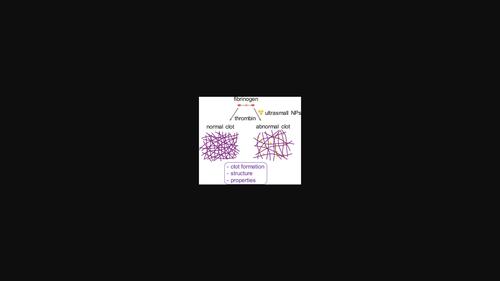超小纳米粒子与纤维蛋白原结合并阻碍正常血凝块的形成
IF 2.7
4区 材料科学
Q3 CHEMISTRY, PHYSICAL
引用次数: 0
摘要
在血液凝固过程中,形成适当的纤维蛋白凝块至关重要,因为异常凝块可能导致出血或血栓形成。尽管存在这些问题,但目前人们对工程纳米材料对纤维蛋白凝块形成的潜在不利影响了解有限。鉴于纤维蛋白原高度集中于血浆中,且具有较大的表面积,使其容易与纳米材料发生意外的相互作用,这种情况令人惊讶。本研究探讨了超小型金纳米粒子(usGNPs)对纤维蛋白凝块形成的影响。由于其独特的物理化学特性和在复杂生物流体中的良好表现,超微金纳米粒子在生物医学应用中获得了极大的关注。研究发现,usGNPs 与纤维蛋白原相互作用,延缓了血凝块的形成,并在形成的纤维蛋白基质中被物理捕获。共聚焦显微镜显示,usGNPs 破坏了纤维蛋白凝块的正常结构,导致网络结构密度降低。这种破坏导致凝块孔径增大,增加了凝块对液体的渗透性。考虑到异常凝块形成可能带来的健康风险,在对 usGNPs 和其他纳米药物进行标准安全评估时,应包括对凝块形成过程的详细检查。本文章由计算机程序翻译,如有差异,请以英文原文为准。

Ultrasmall Nanoparticles Bind to Fibrinogen and Impair Normal Clot Formation
The formation of a proper fibrin clot is essential during blood coagulation, as abnormal clots can predispose individuals to bleeding or thrombosis. Despite these concerns, there is currently limited understanding of the potential adverse effects of engineered nanomaterials on fibrin clot formation. This is surprising, given that fibrinogen is highly concentrated in plasma and has a large surface area, making it prone to unintended interactions with nanomaterials. In this study, the impact of ultrasmall gold nanoparticles (usGNPs) on fibrin clot formation is investigated. UsGNPs have gained significant interest in biomedical applications due to their unique physicochemical properties and favorable behavior in complex biofluids. It is found that the usGNPs interacted with fibrinogen, delayed the onset of clot formation, and became physically trapped within the forming fibrin matrix. Confocal microscopy showed that the usGNPs disrupted the normal architecture of the fibrin clot, resulting in a less dense network structure. This disruption led to larger clot pore sizes and increased clot permeability to liquid. Considering the potential health risks associated with abnormal clot formation, a detailed examination of the clot formation process should be included in the standard safety assessment of usGNPs and other nanomedicines.
求助全文
通过发布文献求助,成功后即可免费获取论文全文。
去求助
来源期刊

Particle & Particle Systems Characterization
工程技术-材料科学:表征与测试
CiteScore
5.50
自引率
0.00%
发文量
114
审稿时长
3.0 months
期刊介绍:
Particle & Particle Systems Characterization is an international, peer-reviewed, interdisciplinary journal focusing on all aspects of particle research. The journal joined the Advanced Materials family of journals in 2013. Particle has an impact factor of 4.194 (2018 Journal Impact Factor, Journal Citation Reports (Clarivate Analytics, 2019)).
Topics covered include the synthesis, characterization, and application of particles in a variety of systems and devices.
Particle covers nanotubes, fullerenes, micelles and alloy clusters, organic and inorganic materials, polymers, quantum dots, 2D materials, proteins, and other molecular biological systems.
Particle Systems include those in biomedicine, catalysis, energy-storage materials, environmental science, micro/nano-electromechanical systems, micro/nano-fluidics, molecular electronics, photonics, sensing, and others.
Characterization methods include microscopy, spectroscopy, electrochemical, diffraction, magnetic, and scattering techniques.
 求助内容:
求助内容: 应助结果提醒方式:
应助结果提醒方式:


